wheel torque AUDI Q5 2014 Owners Manual
[x] Cancel search | Manufacturer: AUDI, Model Year: 2014, Model line: Q5, Model: AUDI Q5 2014Pages: 316, PDF Size: 78.41 MB
Page 199 of 316
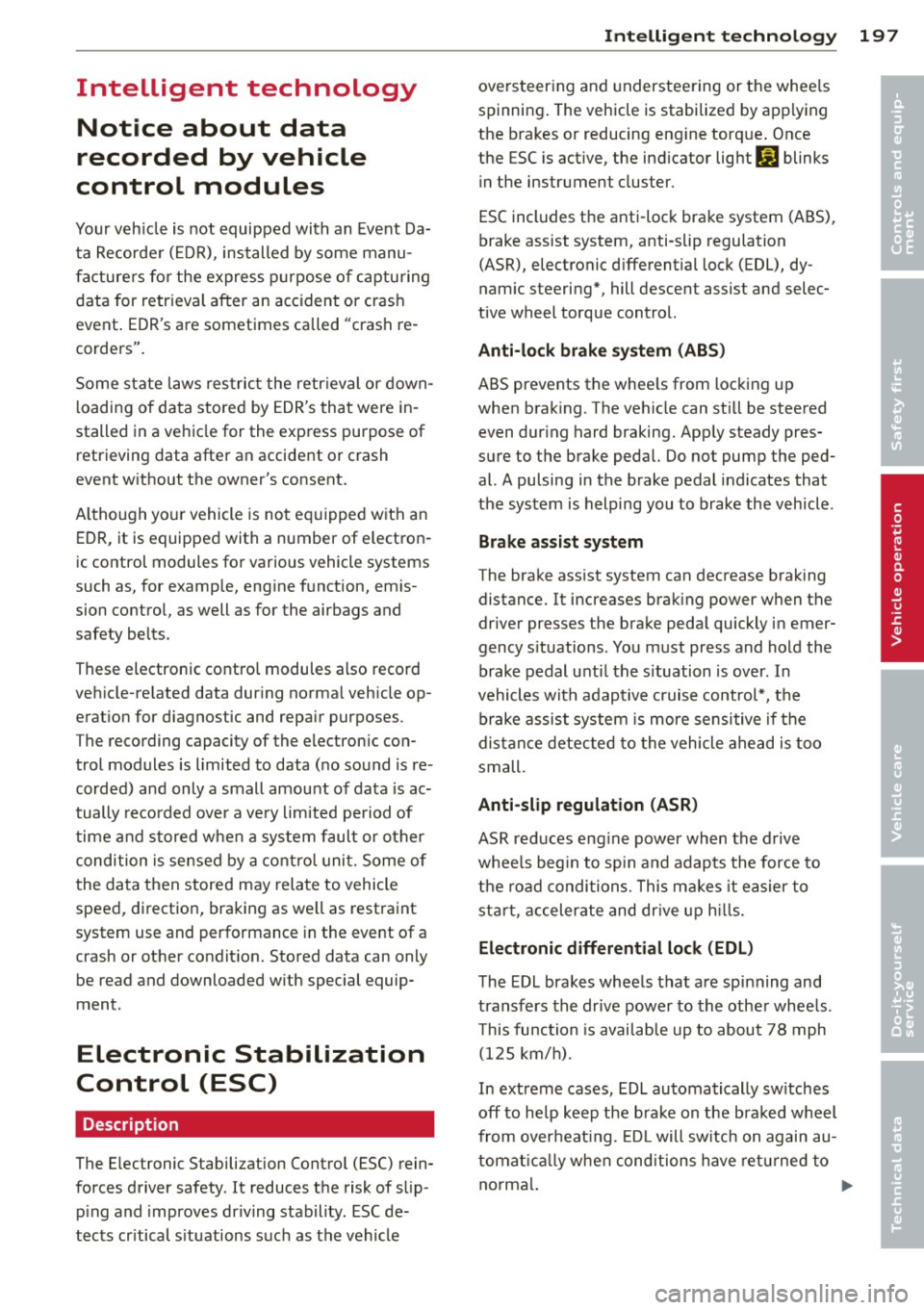
Intelligent technology Notice about data
recorded by vehicle
control modules
Your vehicle is not equipped with an Event Da
ta Recorder (EDR), installed by some manu
facturers for the express purpose of capturing
data for retrieval after an accident or crash
event. EDR's are sometimes called "crash re
corders".
Some state laws restrict the retr ieval or down
loading of data stored by EDR's that were in
stalled in a vehicle for the express purpose of
retrieving data after an accident or crash
event without the owner's consent.
Although your vehicle is not equipped with an
EDR, it is equipped with a number of electron
ic control modules for various vehicle systems
such as, for examp le, engine function, emis
sion control, as well as for the airbags and
safety belts.
These electronic control modules also record
vehicle-related data during norma l vehicle op
eration for diagnostic and repair purposes.
The recording capacity of the electronic con
trol modules is limited to data (no sound is re
corded) and only a small amount of data is ac
tually recorded over a very limited period of
time and stored when a system fault or other
condition is sensed by a control unit. Some of
the data then stored may relate to vehicle
speed, direction, braking as we ll as restraint
system use and performance in the event of a
crash or other condition. Stored data can only be read and downloaded with special equip
ment.
Electronic Stabilization
Control (ESC)
Description
The Electronic Stabilization Control (ESC) rein
forces driver safety. It reduces the risk of slip
ping and improves driving stability. ESC de
tects critical s ituations such as the vehicle
Intelligent technology 197
oversteering and understeering or the whee ls
spinning . The vehicle is stabilized by applying
the brakes or reducing eng ine torque . Once
the ESC is active, the indicator light
G1 blinks
in the instrument cluster.
ESC includes the anti-lock brake system (ABS),
brake assist system, anti-slip regulation
(ASR), electronic differential lock (EDL), dy
namic steering*, hill descent assist and selec
tive wheel torque control.
Anti-lock brake system (ABS)
ABS prevents the whee ls from locking up
when braking . The vehicle can still be steered
even during hard braking. App ly steady pres
sure to the brake pedal. Do not pump the ped
al. A pulsing in the brake pedal indicates that
the system is helping you to brake the vehicle .
Brake assist system
The brake assist system can decrease braking
distance. It increases braking power when the
driver presses the brake pedal quickly in emer
gency situations . You must press and hold the
brake pedal until the situation is over . In
vehicles with adaptive cruise control*, the
brake assist system is more sensitive if the
distance detected to the vehicle ahead is too
small.
Anti-slip regulation (ASR)
ASR reduces engine power when the drive
wheels beg in to sp in and adapts the force to
the road conditions. This makes it easier to
start, accelerate and drive up hill s.
Electronic differential lock (EDL)
The EDL brakes wheels that are spinning and
transfers the drive power to the othe r whee ls .
T his function is available up to about 78 mph
(125 km/h) .
In extreme cases, EDL automatically switches
off to help keep the brake on the braked wheel
from overheat ing. EDL will switch on again au
tomatically when conditions have returned to
normal.
•
•
Page 200 of 316
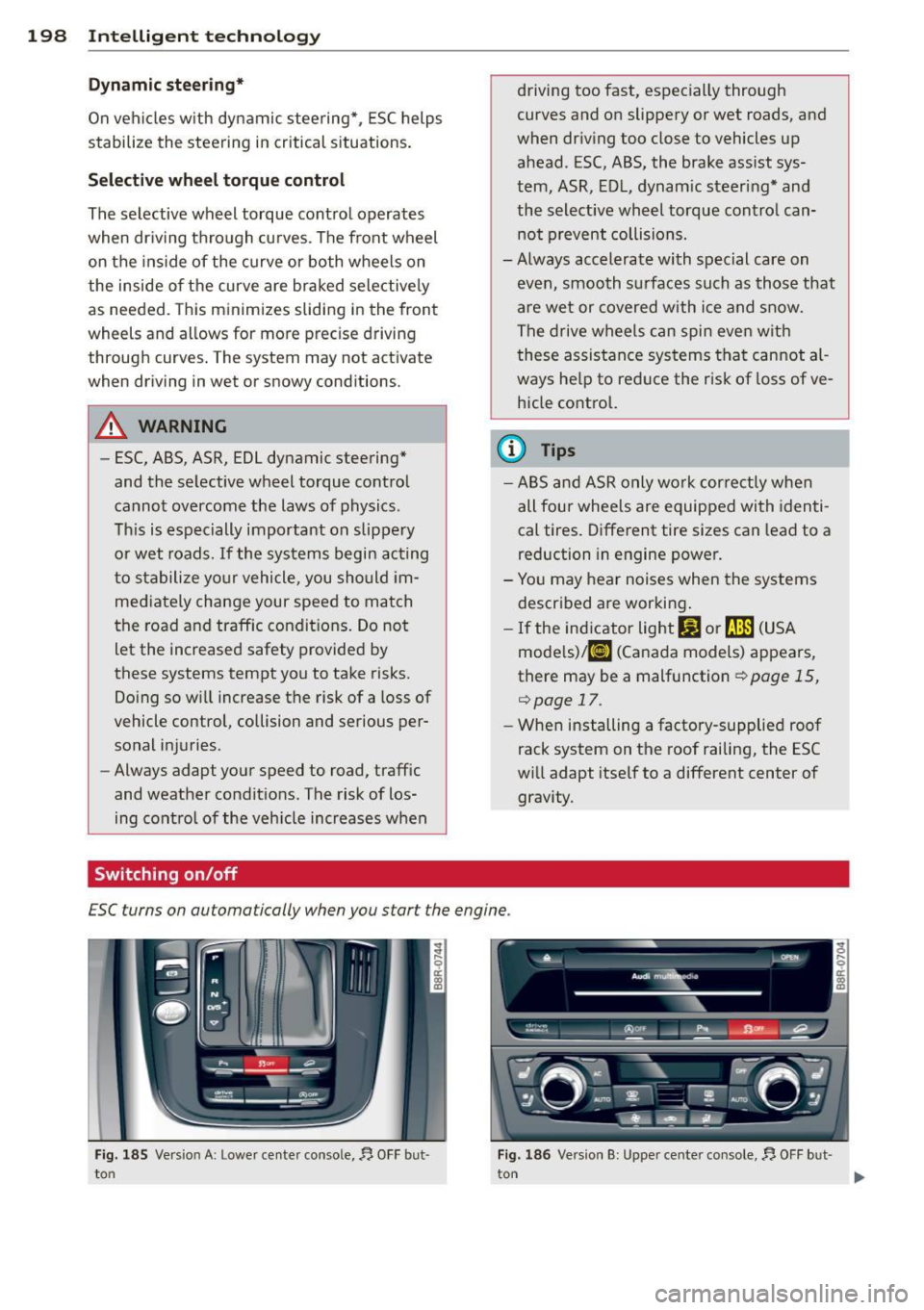
198 Intelligent technology
Dynamic ste ering *
On vehicles with dynamic stee ring* , ES C helps
stabilize the st eering in critical s ituations .
Selective wh eel torque c ontrol
The selective whee l torque control operates
when dr iv ing through curves . T he front wheel
on the inside of the curve or both wheels on
the inside of the curv e are braked selective ly
as needed. This m inimizes sliding in the front
wheels and allows for more pr ecise driving
through curves . T he system may not act ivate
when driving in wet or snowy cond itions .
A WARNING
-ESC, ABS, ASR, EDL dynamic steering"
and the se lective wheel torque control
cannot overcome the laws of physics .
Th is is especially important on slippery
or wet roads.
If the systems begin act ing
to stabilize yo ur vehicle , you sho uld im
med iately change your speed to ma tch
the road and traffic condit ions. Do not
let the increased safety provided by
these systems tempt you to take risks. Do ing so wi ll increase the risk of a loss of
vehicle control, collision and serious per
sonal injuries .
- Always adapt your speed to road, traff ic
and weather condit ions. The risk of Los-
ing cont ro l of the veh icle increases when
Switching on/off
-
driving too fast, espec ially through
curves and on slippery or wet roads, and
when dr iv ing too close to vehicles up
ahead . ESC, ABS, the brake ass ist sys
tem, ASR, ED L, dynam ic steering* and
the selective whe el torque cont ro l can
not p revent collisions.
- Always accelerate with special care on
even, smooth surfaces such as those that
are wet or covered with ice and snow.
The drive wheel s can spin eve n w ith
these assistance sys tems t hat can not al
ways he lp to red uce the risk of loss of ve
hicle control.
(0 Tips
- ABS and ASR only work correctly when
all four whee ls are equipped wi th identi
cal tires . Different tire sizes can lead to a
reduction in engine powe r.
- Yo u may hear noises when the systems
described are working .
-If the ind icator light&] or llB (USA
mode ls)/ [iJ (Canada models) appears,
there may be a malfunction
c:::, page 15,
c:::, page 17.
-When installing a factory-supplied roof
rack system on the roof railing, the ESC
w ill adapt itse lf to a different center of
gravity.
ESC turn s on automa tically when you star t the engine .
Fig . 18 5 Ve rs io n A: L ower ce nte r conso le , fJ. O FF b ut·
to n Fig. 186 Ve rs io n B: Uppe r ce nte r co nso le, fJ. OF F bu t
t on
Page 204 of 316
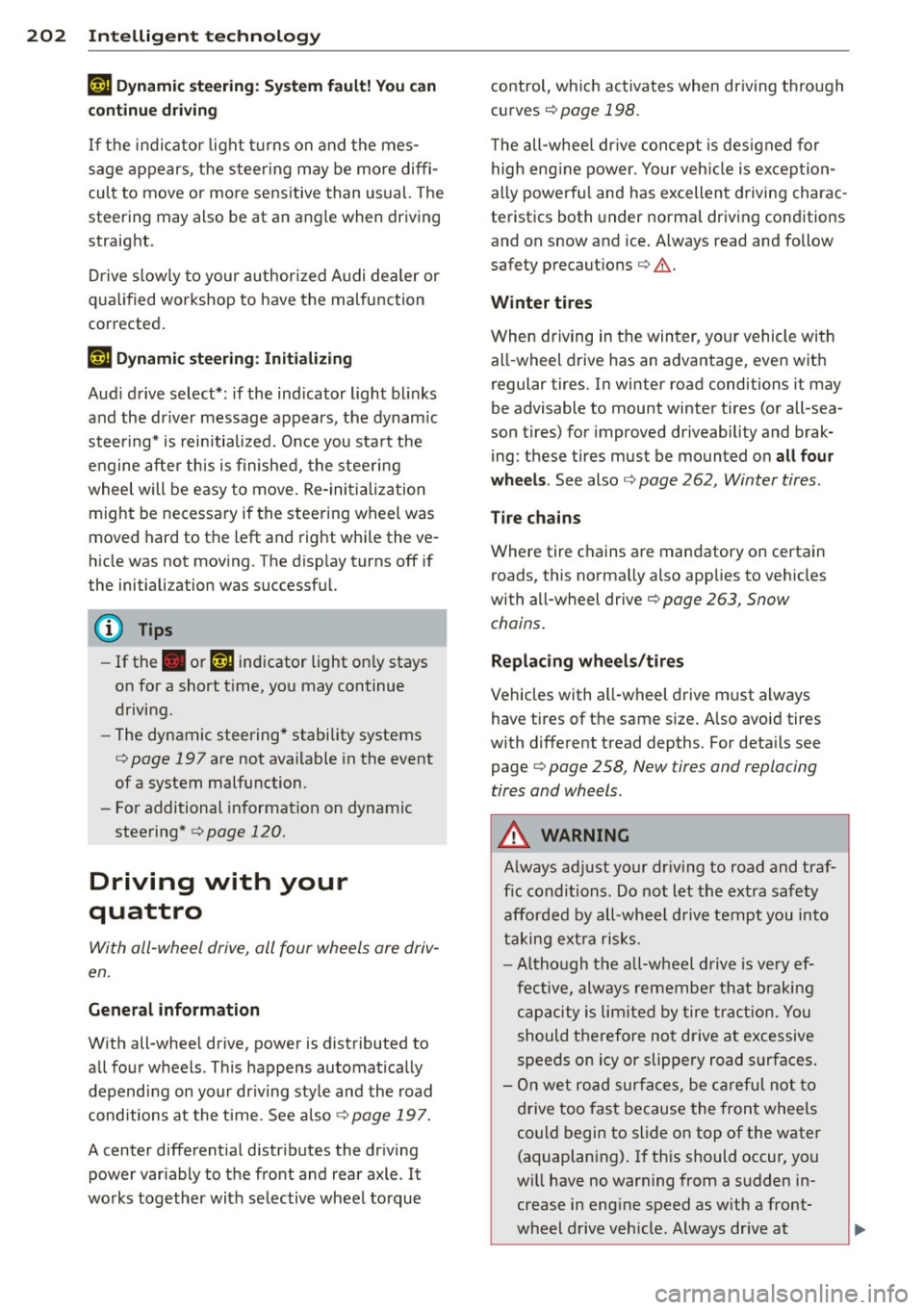
202 Intelligent technology
iT-ij Dynamic steering: System fault! You can
cont inue driving
If the indicator light turns on and the mes
sage appears, the steer ing may be more diffi
cult to move or more sensitive than usual. The
steering may also be at an angle when driving
straight.
Drive slow ly to your authorized Audi dealer or
qualified workshop to have the malfunction
corrected .
iT-ij Dynamic steering: Initializing
Audi drive select*: if the indicator light blinks
and the driver message appears, the dynamic
steer ing* is reinitialized. Once you sta rt the
engine after this is finished, the steering
wheel will be easy to move. Re-ini tialization
might be necessary if the steering wheel was
moved hard to the left and right while the ve
h icle was not moving . The display turns off if
the initiali zation was successful.
- If the . or
tTij indicator light on ly stays
on for a short time, you may continue
driving.
- The dynamic steering* stability systems
¢
page 197 are not available in the event
of a system malfunction.
- For additional information on dynamic
steering* ¢
page 120.
Driving with your
quattro
With all-wheel drive, all four wheels are driv
en.
General information
W ith all-wheel dr ive, power is distributed to
all four wheels. This happens automatically
depending on your driving sty le and the road
conditions at the time . See also ¢
page 197.
A center different ial distr ibutes the dr iv ing
power var iably to the front and rear axle . It
works together with se lective wheel torque control, which activates when driving through
curves
r=:>
page 198.
The all-wheel drive concept is designed for
high eng ine power. Your veh icle is except ion
ally powerfu l and has excellent driving charac
teristics both under normal driving conditions
and on snow and ice . Always read and follow
safety precaut ions r=;,
,&.
Winter tires
When driving in the winter, your vehicle with
all-wheel drive has an advantage, even with
regular tires. In winter road conditions it may
be advisable to mount winter tires (or all-sea
son tires) for improved driveability and brak
ing : these tires must be mounted on
all four
wheels.
See also r=;, page 262, Winter tires.
Tire chains
Where tire chains are mandatory on certain
roads, this norma lly also app lies to veh icles
with all-wheel driver=;,
page 263, Snow
chains .
Replacing wheels/tires
Vehicles with a ll-wheel drive must always
have tires of the same size. A lso avoid tires
with different tread depths. For deta ils see
page
r=;, page 2 SB, New tires and replacing
tires and wheels.
A WARNING
-Always adjust your dr iv ing to road and traf-
f ic conditions. Do not let the extra safety
afforded by all-wheel drive tempt you into
taking extra risks .
- Although the all-wheel drive is very ef
fective, always remember that braking
capacity is lim ited by tire traction. You
should therefore not drive at excessive
speeds on icy or slippery road surfaces.
- On wet road surfaces, be careful not to
drive too fast because the front wheels
could begin to slide on top of the water
(aquaplaning). If this should occur, you
will have no warning from a sudden in crease in eng ine speed as w ith a front
wheel drive veh icle. Always drive at
Page 266 of 316
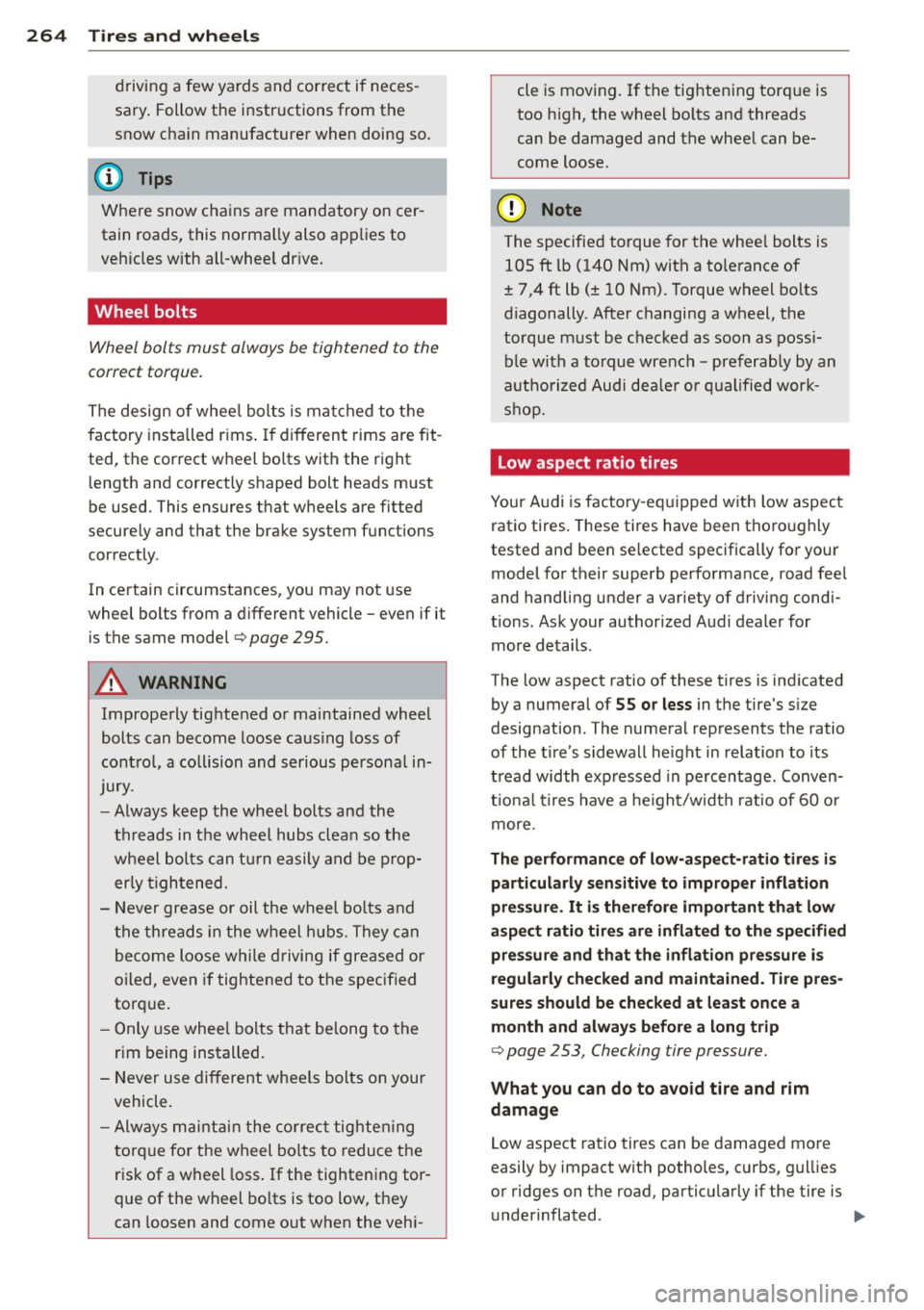
264 Tire s and wheel s
driving a few yards and correct if neces
sary. Follow the instructions from the
snow cha in manufacturer when doing so.
(D Tips
Where snow chains are mandatory oncer
tain roads, this normally also applies to
veh icles with all-wheel dr ive .
Wheel bolts
Wheel bolts must always be tightened to the
correct torque.
The design of whee l bolts is matched to the
factory insta lled rims . If different rims are fit
ted, the correct wheel bolts with the right l ength and correctly shaped bolt heads must
be used. This ensures that wheels are f itted
securely and that the brake system functions
correctly .
In certain circumstances, you may not use
wheel bolts from a different vehicle -even if it
is the same model
¢ page 295.
.&_ WARNING
Improperly tig htened or maintained wheel
bolts can become loose ca using loss of
cont ro l, a co llision and serious p ersona l in
Jury.
- Always keep the wheel bolts and the
threads in t he wheel hubs clea n so the
wheel bolts can tu rn easily and be prop
erly tigh tened.
- N ever grease or oil the wheel bo lts and
the threads in the wheel h ubs. They can
become loose w hile d riving if greased or
oiled, even if tightened to the specified
torq ue.
- Only use wheel bolts that be long to the
rim being installed.
- N ever use different whee ls bolts on your
vehicle.
- Always mai nta in the co rrec t tighte ning
tor que fo r the wheel bo lts to reduce the
risk of a wheel loss . If the tightening tor
que of the wheel bo lts is too low, they
can loosen and come out when the veh i- cle is moving.
If the tightening torque is
too high, the wheel bolts and threads
can be damaged and the wheel can be
come loose.
(D Note
The specified torque for the whee l bolts is
105 ft lb (140 Nm) with a to lerance of
± 7,4 ft lb(± 10 Nm). Torque wheel bolts
diagonally . After changing a wheel, the
torque must be checked as soon as poss i
ble with a to rque wrench -preferab ly by an
a uthorized Aud i dea le r or qualified wor k
shop.
Low aspect ratio tires
Your A udi is factory -eq uipped w it h low aspect
ratio tires. These tires have been thoroughly
tested and been se lected specifically for your
model for their superb performance, road fee l
and handling under a variety of driving condi
t ions . Ask your authorized Audi dealer for
more details .
The low aspect ratio of these tires is ind icated
by a numeral of
55 or less in the tire's s ize
designation . The numeral represents the ratio
of the tire's sidewall height in relation to its
t read width exp ressed in percentage. Conven
tiona l tires have a he ight/w idth rat io of 60 or
more.
Th e performanc e of low-a spect-ratio tire s is
pa rticularly sensi tive to improp er inflation
pre ssure. It i s ther efor e important that low
a spe ct ratio tir es are inflated to the spe cified
pre ssure and that the inflation pre ssure i s
regula rly checked and mainta ined. Tire pre s
sure s should be checked at lea st once a
month and al way s befo re a long trip
¢ page 2 53, Checking tire pressure.
What you can do to a void tire and rim
damage
Low aspect ratio tires can be damaged more
easily by impact w ith potholes, curbs, gul lies
or ridges on the road, particularly if the tire is
underinflated . ..,.
Page 279 of 316
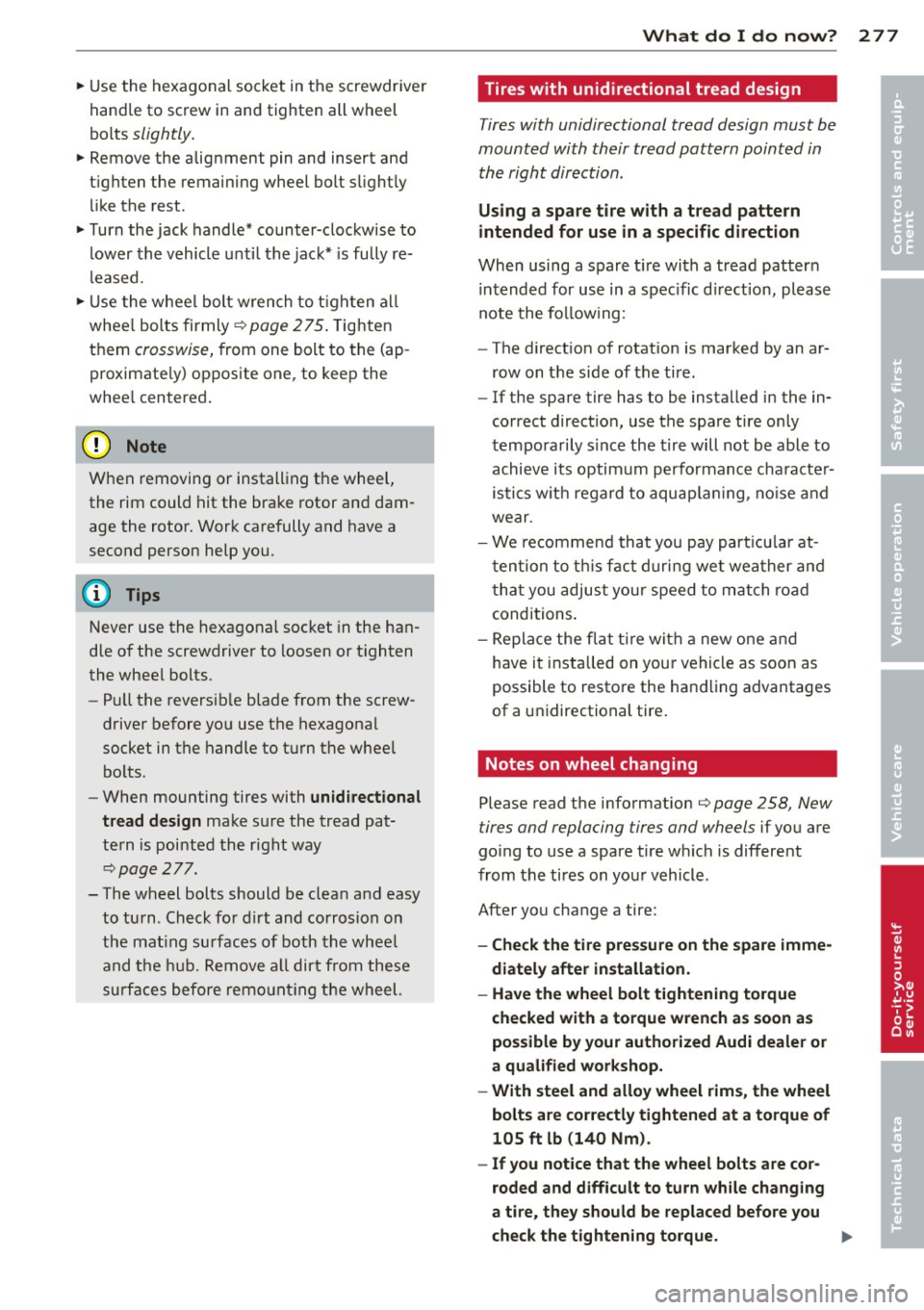
~ Use the hexagonal socket in the screwdriver
handle to screw in and tighten all wheel
bo lts
slightly .
~ Remove the alig nment pin and insert and
t igh ten the remaining wheel bolt s light ly
Like t he rest.
~ Turn th e jack handle* counter-clockwise to
l ower the vehicle unti l the jack* is fully re
leased .
~ Use the whee l bolt w rench to t ighten a ll
whee l bolts firmly <=>
page 2 75. Tighten
them
crosswise, from one bolt to the (ap
proximate ly) opposite one, to keep the
whee l centered.
Q;) Note
When removing or installing the wheel,
the rim could hit the brake rotor and dam
age the rotor. Work carefully and have a
second person help you.
(D} Tips
Never use the hexagonal socket in the han
dle of the screwdriver to loosen or tighten
the wheel bolts .
- Pull the reversib le b lade from the screw
driver before yo u use the hexagonal
socket in the handle to t urn the whee l
bo lts .
- When mounting tires with
unid irectional
tread design
make sure the tread pat
te rn is poi nted the right way
<=> page 2 77.
- The wheel bolts should be clea n and easy
to tu rn . Check for d irt and corrosion on
the mat ing s urfaces of both the wheel
and the hub. Remove a ll dirt from these
su rfaces before remo unting the wheel.
What do I do now? 277
Tires with unidirectional tread design
Tires with unidirectional tread design must be
mounted with their tread pattern pointed in the right direction .
Using a spa re tire with a tread pattern
intended for use in a specific direction
When using a spare t ire wi th a tread pat ter n
intended for use in a spec ific d irect ion, please
note the fo llowing :
- The d irect io n of rotation is marked by an ar
row on t he side of the ti re .
- If the spare tire has to be insta lled in the in
correct d irect ion, use the spare tire only
temporarily s ince the t ire will not be able to
achieve its optimum performance cha racte r
is tic s w it h regard to aquap la ni ng, no ise and
wear .
- We recommend that you pay part icu lar at
t en tion to th is f act d uring we t wea ther and
t ha t you adjus t you r speed to m atch r oad
conditions .
- Repla ce the fl at t ire wi th a new o ne and
have i t installed on your vehicle as soo n as
possible to resto re the han dling advantages
of a u nidirectional tire .
Notes on wheel changing
Please read the information¢ page 258, New
tires and replacing tires and wheels
if yo u a re
go ing to use a spare tire w hich is different
from the tires on yo ur vehicle .
After you change a tire:
- Check the tire pre ssure on the spare imme
diately after installation.
- Have the wheel bolt tightening torque
checked with a torque wrench as soon a s
possible by your authorized Audi dealer or
a qualified workshop.
- With steel and alloy wheel rims , the wheel
bolts are cor re ctly tightened at a torque of
105 ft lb (140 Nm).
- If you notice that the wheel bolts are cor
roded and diff icult to turn while changing
a tire, they should be replaced before you
check the t ightening torque. .,,.
•
•
Page 300 of 316
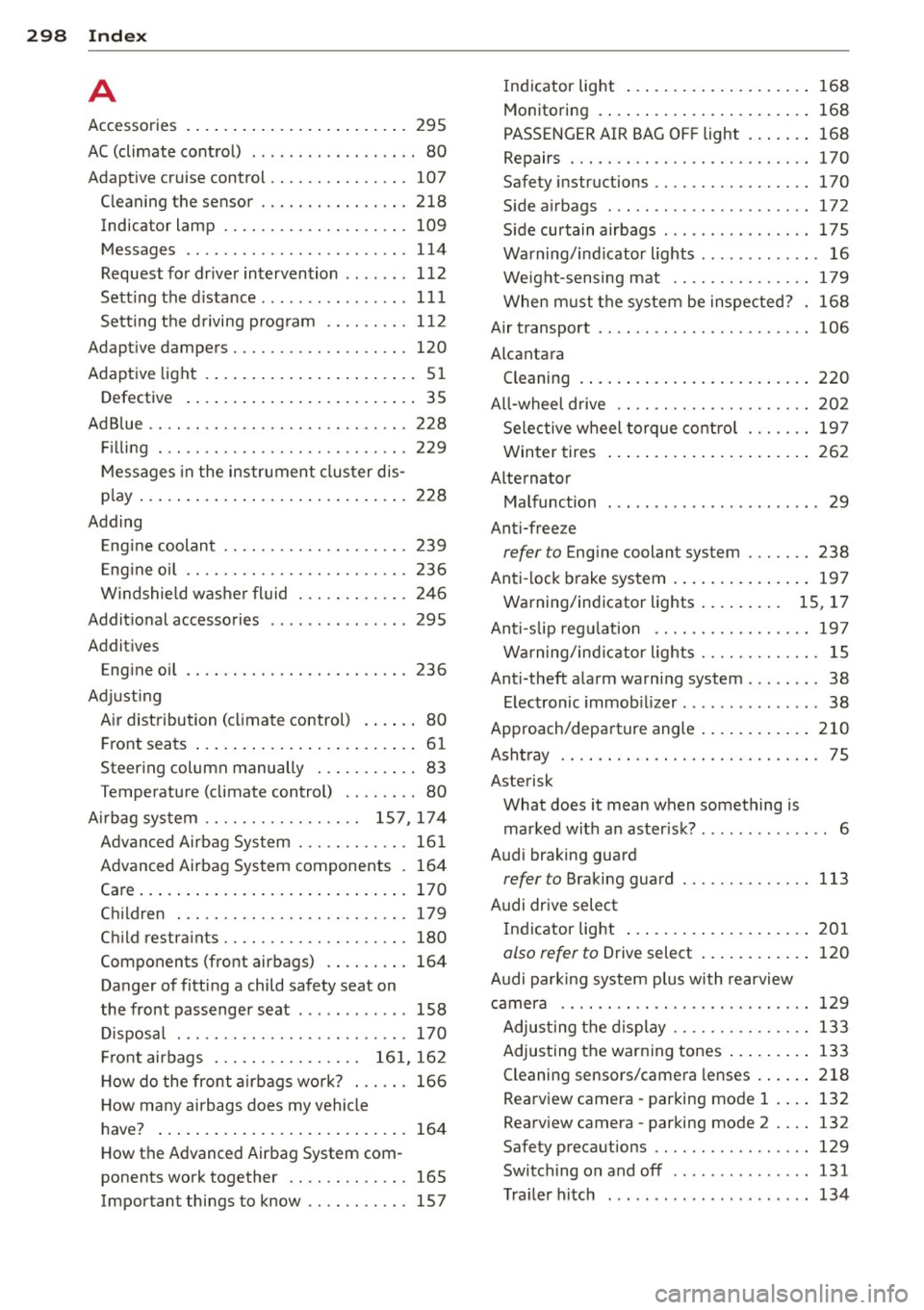
298 Index .:..:..:..::....::.....:..._ ___________________________ _
A
Accessories . .. .. .. ..... ... .. .. .... . 295
AC (climate control) . . . . . . . . . . . . . . . . . . 80
Adapt ive cr uise control . . . . . . . . . . . . . . . 107
C leaning the sensor ....... .. .. .... . 218
Indica tor lamp . . . . . . . . . . . . . . . . . . . . 109
Messages .. ..... ........... ... .. . 114
Request fo r dr iver intervention . . . . . . . 11 2
Sett ing the d istance ........ ... .. ... 111
S ett ing t he d riving p rog ram .. .. .... . 112
Adapt ive dampers . . . . . . . . . . . . . . . . . . . 120
A dapt ive light . .. . ...... ... .. .. .... .. 51
D efective . . . . . . . . . . . . . . . . . . . . . . . . . 3 5
AdB lue .. .. .. ............. .. .. .. .. . 228
Fil ling . .. .... ........... .. .. .... . 229
M essages in the ins trument clus ter dis -
p lay .. ... ... .. .. ..... ... .. .. .... . 22 8
Adding Eng ine coolant ........... .. .. .... .
E ng ine oil ............... .. .. .. .. .
W indshie ld w asher fl uid ... .. .. .... .
Addit ional accesso ries
Additives 239
236
2 4 6
295
E ngine oil .... ........... .. .. .... . 236
Ad justing
A ir dist ribution ( clima te control) . ... . . 80
Fr ont seats .... . ...... ... .. .. .... .. 61
Steer ing column manually ... .. .. .. . . 83
Temperature (climate control) .. .... .. 80
A irbag sys tem . . . . . . . . . . . . . . . . . 1 57, 174
Advan ced Airbag Sys tem ... .. .. .. .. . 16 1
Advanced Airbag Sys tem components . 164
Ca re ..... .. ... .. ..... ... .. .. .... . 170
C hil dren . .... ........... .. .. .... . 179
C hi ld restra ints ............. .. .... . 180
Components (front airbags) .. .. .... . 164
Danger of fitt ing a child safety seat on
the front passenger seat ....... .. ... 158
Di sposa l . . . . . . . . . . . . . . . . . . . . . . . . . 170
Fr ont airbags . . . . . . . . . . . . . . . . 16 1, 16 2
H ow do the front airbags wo rk? . .... . 166
H ow ma ny airbags does my vehi cle
have? ...... .. .. ..... ... .. .. .... . 164
H ow t he A dvanced Airbag System com
ponents work together . . . . . . . . . . . . . 165
Important things to know .... .. .... . 157 Indicator lig
ht ... ... .. ..... .... . .. 168
Monito ring . ..... .. ... ..... ... .. .. 168
PASSENGER AIR BAG OFF light ... .. .. 168
Repairs ... .... .. ............. .... 170
Safety instr uctions ............. .... 170
S ide a irbags ..... ................ . 172
S ide cu rtain airbags .... .. ... ..... .. 175
Warning/ind icator lights ........... .. 16
We igh t-sensing mat ........... .. .. 179
When m ust t he sys tem be inspected? . 168
Air transport .. .. .. .......... ...... . 106
Alcantara Cleaning . ..... .. ... .. ..... .... . .. 220
All-wheel drive .. .. .. ........... .. .. 202
Se lective wheel torque con trol ... .... 19 7
Winter tires ..... .. ... ..... ... .. .. 262
Alternato r
Malfunction . . . . . . . . . . . . . . . . . . . . . . . 29
Anti-free ze
refer to Eng ine coolant system ... .... 238
An ti-l ock b rake system . .. ..... ... .. .. 197
Warning/ind icator lights . . . . . . . . . 15 , 17
Anti-s lip reg ulatio n ............. .. .. 19 7
Warning/ind icator lights ........ .. .. . 15
Anti-theft a larm warn ing system . ...... . 38
E lectronic immob ilizer ....... ...... .. 38
Approach/depa rture angle ..... ... .. .. 210
Ash tray .... .... ................... . 75
Asterisk What does it mean when something is marked wit h an aster isk? . . . . . . . . . . . . . . 6
Audi braking guard
refer to Braking guard .......... .. .. 113
Audi dr ive selec t
Indicator light ... .. ... ..... ... .. .. 2 01
also refer to Drive select ..... ... .. .. 120
Audi par king syste m plus with rearview
c amer a .. .. .. .. .. .... ......... .... 1 29
Adjus ting the d isplay ........... .. .. 133
Adjus ting the warning tones ... .. .. .. 133
Cleaning sensors/came ra lenses . ... .. 218
Rea rv iew camera - parking mode 1 . ... 132
Rea rv iew camera - parking mode 2 .. .. 132
Safety precautions ............. .... 129
Switching on and off ... .. ... ..... .. 131
T ra iler h itc h ..... ................ . 134
Page 310 of 316
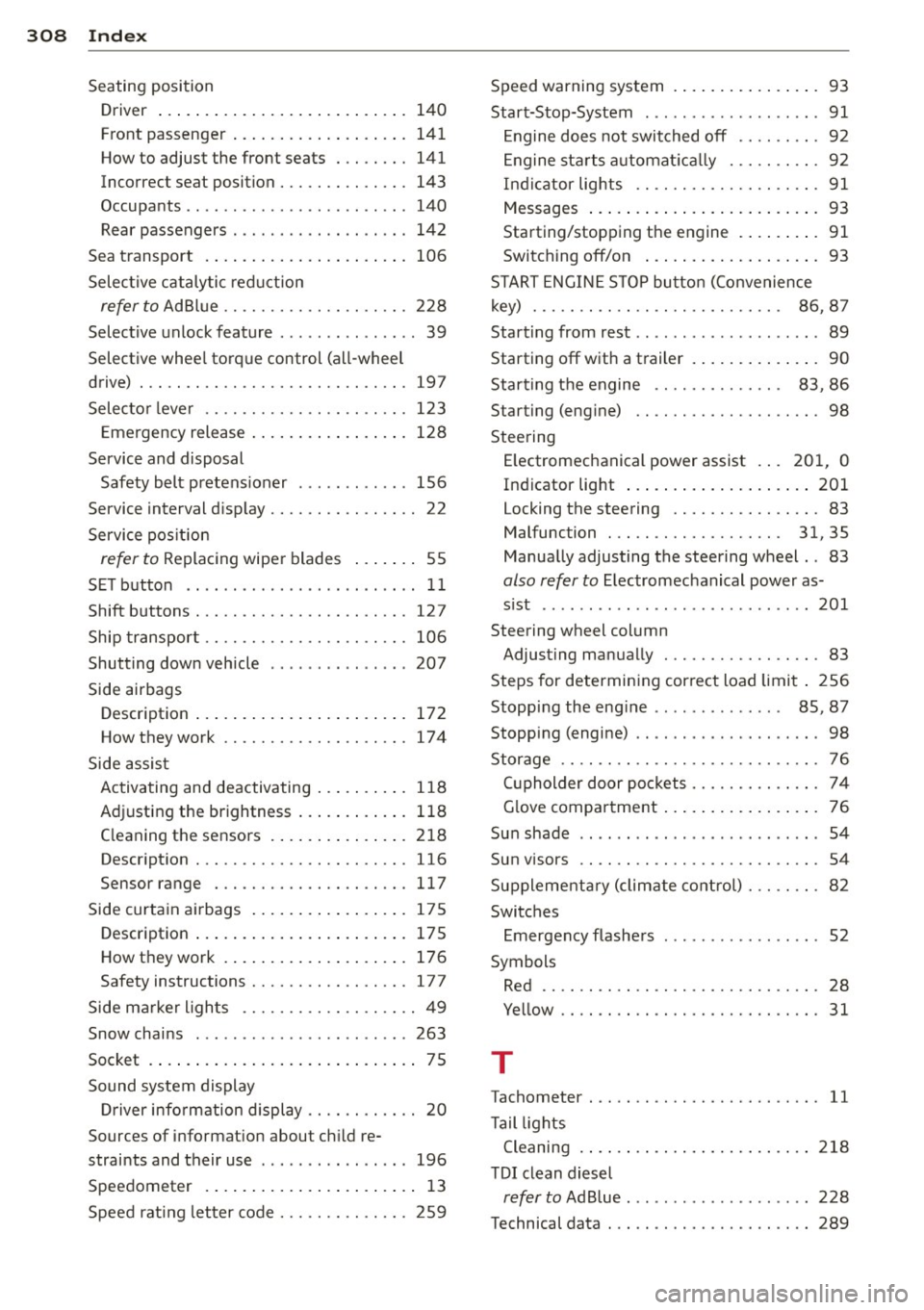
308 Index
Seating position Driver ..... ................ ..... . 140
Front passenger .............. .... . 141
How to adjust the front seats . . . . . . . . 141
Incorrect seat position . . . . . . . . . . . . . . 143
Occupants .. ................ ... ... 140
Rear passengers ....... ..... .. .. .. . 142
Sea transport . . . . . . . . . . . . . . . . . . . . . . 106
Selective catalytic reduction
refer to Ad Blue ........... .... .. .. . 228
Selective unlock feature ............... 39
Selective whee l torque control (all-wheel
drive) ... .... ...................... 197
Selector lever .. ........... .. .. .... . 123
Emergency release .......... .. .... . 128
Service and disposal Safety belt pretens ioner ....... .. ... 156
Service interval disp lay . . . . . . . . . . . . . . . . 22
Service position
refer to Replacing wiper blades ... .. .. 55
SET button . . . . . . . . . . . . . . . . . . . . . . . . . 11
Shift buttons .................. .... . 127
Ship transport ...................... 106
Shutting down vehicle ....... .... .... 207
Side airbags Description ............... ... .... . 172
How they work ........... .... ..... 174
Side assist
Activating and deactivating ..... .... . 118
Adjusting the brightness ..... .... .. . 118
C leaning the sensors ....... ... .. ... 218
Description .................. ..... 116
Sensor range . . . . . . . . . . . . . . . . . . . . . 117
Side curta in airbags .......... .. .... . 175
Description ............... ... .... . 175
How they work ............ ... .... . 176
Safety instructions ............ .... . 177
Side marker lights ................... 49
Snow chains ........... .... .... .... 263
Socket . ..... ................ ..... .. 75
Sound system display
Driver information display . . . . . . . . . . . . 20
Sources of information about child re-
straints and their use ........... .. ... 196
Speedometer . . . . . . . . . . . . . . . . . . . . . . . 13
Speed rating letter code ....... .. .... . 259 Speed warning system ...........
.. .. . 93
Start-Stop-System . . . . . . . . . . . . . . . . . . . 91
Engine does not switched off ......... 92
Engine starts automatica lly ... .. .. .. . 92
Indicator lights .................... 91
Messages ..... .. .. .............. .. 93
Starting/stopping the engine .... .. .. . 91
Switching off/on . . . . . . . . . . . . . . . . . . . 93
START ENG INE STOP button (Convenience
key) . . . . . . . . . . . . . . . . . . . . . . . . . . . 86, 87
Starting from rest .................... 89
Starting off with a trailer .......... ... . 90
Starting the engine . . . . . . . . . . . . . . 83, 86
Starting (engine) .................... 98
Steering Electromechanical power assist . . . 201, 0
In dicator light ... ................. 201
Locking the steering ................ 83
Malfunction . . . . . . . . . . . . . . . . . . . 31, 35
Manually adjusting the steering wheel .. 83
also refer to Electromechanical power as-
s ist ......... ... .. .............. . 201
Steering wheel column
Adjusting manually ............ .. .. . 83
Steps for determining correct load limit . 256
Stopping the engine . . . . . . . . . . . . . . 85, 87
Stopping (engine) .. ............. .. .. . 98
Storage .. .. .. .. .. ............... ... 76
Cu pholder door pockets . . . . . . . . . . . . . . 7 4
G love compartment . . . . . . . . . . . . . . . . . 76
Sun shade .................. ........ 54
Sun visors .. .... .................... 54
Supplementary (climate control) ..... .. . 82
Switches Emergency flashers . . . . . . . . . . . . . . . . . 52
Symbols Red .............................. 28
Yellow .... .... ................... . 31
T
Tachometer . . . . . . . . . . . . . . . . . . . . . . . . . 11
T ail lights
Cleaning .. .. .. .. ................. 218
TDI clean diesel
refer to Ad Blue ........ ........... . 228
Technical data ...................... 289